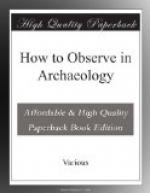Characteristics. Typical ‘Gudea’ style of sculpture, in round and relief (Telloh, Louvre); materials hard diorite, dolerite and basalt as well as limestone: characteristic treatment of eye with heavily marked brows: elaborate tiaras and head-dresses of female figures, &c. Very high development. Regular use of cuneiform on clay tablets and cones (see XV, Figs. 13-15); non-cuneiform character (in a developed form) still used in brick stamps (XV, Fig. 10) and on stone monuments. Bricks (XIV, Fig. 4) now rectangular and well made, either square (14 ins., usually, by 2 1/2 ins. thick) or oblong (11 1/2 x 8 x 2 1/2 ins., or 10 x 5 x 2 1/2 ins.) with stamps or incised inscriptions of Ur-Engur, Dungi, Bur-Sin, Gudea and other kings (XV, Fig. 10), from Ur, Shahrein, Telloh, Niffer, &c. Bricks of Bur-Sin from Shahrein often have inscription-stamps also on the smaller sides (thickness). Great buildings of crude and baked brick (Telloh, Ur); temple-towers (ziggurats) of crude brick faced with burnt brick (Ur, Shahrein, Niffer). Town ruins of Hammurabi’s age (Babylon): crude brick: plans always confused and haphazard. Bitumen still used for mortar. Burials, contracted, often in double pots (mouth to mouth), sealed with bitumen. With the bodies are found large numbers of agate and cornelian beads, unpolished.
Mounds of this period may be recognized by the typical square or oblong bricks (often with thumb-holes), with stamps of kings’ names, &c., in non-cuneiform characters, or with hand-incised inscriptions in early cuneiform, made while the clay was wet; clay tablets or cones inscribed in early cuneiform; copper nails (those with gold-plated heads found at Shahrein may also date from this time); drab or black pottery sherds with impressed or incised designs, generally rough and evidently made with a piece of stick or the thumb-nail; rough stone quern-slabs with rubbers, grinding and hammer-stones, &c.; and the burials described above (these, however, also occur in later times).
IV. LATER BRONZE AGE: Kassite, Middle Babylonian, and Early Assyrian periods; c. 1800- 1000 B.C.
Characteristics. Stabilization of Babylonian art; typical ‘Kassite’ cylinder-seals with straight sides (XIV, Fig. 6); disappearance of old non-cuneiform character with gradual disuse of Sumerian; early stone-cut inscriptions in cuneiform (see XV, Fig. 16; an Elamite inscription). Occasional and rare appearance of glazed pottery (imitation of Egyptian), and multi-coloured glass; early Assyrian sculpture (those unversed in minutiae of Mesopotamian art will only be able to tell this earlier work from the later by the earlier style of the accompanying inscriptions). Not many mounds of this period have been dug.
V. EARLY IRON AGE: 1. Late Babylonian and Assyrian periods; c. 1000-540 B.C.




